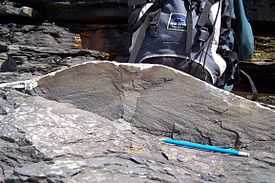Sand volcano

A sand volcano or sand blow is a cone of sand formed by the ejection of sand onto a surface from a central point. The sand builds up as a cone with slopes at the sand's angle of repose. A crater is commonly seen at the summit. The cone looks like a small volcanic cone[1] and can range in size from millimetres to metres in diameter.
The process is often associated with earthquake liquefaction and the ejection of fluidized sand that can occur in water saturated sediments during an earthquake. The New Madrid Seismic Zone exhibited many such features during the 1811-1812 series of earthquakes.[2] Linear sand blows are just as common, and can still be seen in the New Madrid area.
In the past few years, much effort has gone into the mapping of liquefaction features to study ancient earthquakes.[3] The basic idea is to map zones that are susceptible to the process and then go in for a closer look. The presence or absence of earthquake liquefaction features is strong evidence of past earthquake activity, or lack thereof.
These are to be contrasted with mud volcanoes which occur in areas of geyser or subsurface gas venting.
References
- ↑ Images after 2010 Canterbury earthquake
- ↑ "Historic Earthquakes: New Madrid Earthquakes 1811-1812". United States Geological Survey. Retrieved March 7, 2010.
- ↑ Crone, Anthony J; Wheeler, Russell L (2000). "Data for Quaternary Faults, Liquefaction Features, and Possible Tectonic Features in the Central and Eastern United States, East of the Rocky Mountain Front". United States Geological Survey. Open-File Report 00-0260.
| Wikimedia Commons has media related to Sand volcanoes. |